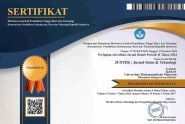Menjaga Mutu Pendidikan di Tengah Pandemi Covid-19: Studi Pembelajaran Online di Universitas Islam Negeri Walisongo Semarang
Abstract
Abstrak: Berbagai usaha dilakukan Pemerintah bekerjasama dengan perguruan tinggi demi mengurangi penyebaran Covid-19 di lingkungan kampus. Rektor UIN Walisongo Semarang menanggapi himbauan Pemerintah, salah satunya dengan melaksanakan pembelajaran online. Penelitian ini merupakan penelitian kualitatif deskriptif yang bertujuan untuk memperoleh gambaran pembelajaran online masa pandemi Covid-19 di Fakultas Dakwah dan Komunikasi,.Data dikumpulkan melalui aplikasi Google Form. Analisis data dilakukan menggunakan teknik analisis interaktif Miles & Huberman. Hasil penelitian menunjukkan bahwa pembelajaran online membuat mahasiswa merasa lebih nyaman untuk bertanya dan mengemukakan pendapatnya dibanding perkuliahan tatap muka, Efektivitas pembelajaran online berkaitan dengan ketersediaan layanan internet dan platform e-learning berbiaya rendah. Hal ini terbukti dengan platform Whatsapp Group (WAG) menempati urutan pertama diikuti Line, Google Classroom, Google Meet, Zoom, kemudian platform selain ini, dan Webex menempati urutan terakhir.
Keywords
Full Text:
Download (PDF)References
Aisa, A, and L Lisvita. 2020. “Penggunaan Teknologi Informasi Dalam Pembelajaran Online Masa Covid-19.” JoEMS (Journal of Education and Management … 3(4).
Andini, N F. 2020. “Dampak Pembelajaran Daring Bagi Mahasiswa Masa Pandemi Covid-19.” Academia.Edu (2020).
Arzayeva, Maiya, Kalzhan Rakhimzhanov, Aliya Abdrahmanova, and Ulan Umitkaliev. 2015. “Special Aspects of Distance Learning in Educational System.” Anthropologist 22(3): 449–54.
Bell, David et al. 2006a. “Nonpharmaceutical Interventions for Pandemic Influenza, International Measures.” Emerging Infectious Diseases 12(1): 81–87.
———. 2006b. “Nonpharmaceutical Interventions for Pandemic Influenza, National and Community Measures.” Emerging Infectious Diseases 12(1): 88–94.
Caley, Peter, David J. Philp, and Kevin McCracken. 2008. “Quantifying Social Distancing Arising from Pandemic Influenza.” Journal of the Royal Society Interface 5(23): 631–39.
CNN Indonesia. (2020). 65 kampus kuliah dari rumah, sultan yogya ragukan efektivitas. Retrieved from https://www.cnnindonesia.com/nasional/20200316110707-20483756/65-kampus-kuliah-dari-rumah-sultan-yogya-ragukan-efektivitas
Darmalaksana, Wahyudin, R. Yuli Ahmad Hambali, Ali Masrur, and Muhlas. 2020. “Analisis Pembelajaran Online Masa WFH Pandemic Covid-19 Sebagai Tantangan Pemimpin Digital Abad 21.” Karya Tulis Ilmiah (KTI) Masa Work From Home (WFH) Covid-19 UIN Sunan Gunung Djati Bandung Tahun 2020 1(1): 1–12.
Enriquez, M. A. S. (2014). Students ’perceptions on the effectiveness of the use of edmodo as a supplementary tool for learning. DLSU Research Congress. https://doi.org/10.1017/CBO9781107415324.004
Iftakhar, S. (2016). GOOGLE CLASSROOM: WHAT WORKS AND HOW? Journal of Education and Social Sciences.
Jatmoko, Dwi, and Mahfudz Faizun. 2020. “Persepsi Mahasiswa Terhadap Pelayanan Pembelajaran Online Di Masa Pandemi Covid-19.” Jurnal Pendidikan Surya Edukasi (JPSE) 6(1): 104–13.
Korucu, A. T., & Alkan, A. (2011). Differences between m-learning (mobile learning) and elearning, basic terminology and usage of m-learning in education. Procedia - Social and Behavioral Sciences. https://doi.org/10.1016/j.sbspro.2011.04.029
Kumar, V., & Nanda, P. (2018). Social media in higher education. International Journal of Information and Communication Technology Education. https://doi.org/10.4018/ijicte.2019010107
Kwon, M., Lee, J. Y., Won, W. Y., Park, J. W., Min, J. A., Hahn, C., … Kim, D. J. (2013). Development and Validation of a Smartphone Addiction Scale (SAS). PLoS ONE. https://doi.org/10.1371/journal.pone.0056936
Laura, B. P., Anabela P., Lina, C., Juan, A. J. M. (2016). Learning with mobile technologies – students behavior. Proceeding of Computers in Human Behavior. P. 1-9. doi:10.1016/j.chb.2016.05.027.
Lembaga Penjaminan Mutu UIN Walisongo. (2020). Instrumen Monitoring dan Evaluasi Sarana Aplikasi Perkuliahan Online/ Daring (E-Learning)
Miles, M. B., & Huberman, M. (1994). Qualitative Data Analysis Second Edition. SAGE Publications.
Milman, N. B. (2015). Distance education. In International Encyclopedia of the Social & Behavioral Sciences: Second Edition. https://doi.org/10.1016/B978-0-08-097086-8.92001-4
Moore, J. L., Dickson-Deane, C., & Galyen, K. (2011). E-Learning, online learning, and distance learning environments: Are they the same? Internet and Higher Education. https://doi.org/10.1016/j.iheduc.2010.10.001
Muharam, Suhari. 2020. “DILEMA PEMBELAJARAN DI MASA PANDEMI.” Osteoarthritis and Cartilage 28(2): 1–43.
Purandina, I Putu Yoga. 2020. “Pendidikan Karakter Tumbuh Selama Pandemi Covid-19.” COVID-19: Perspektif Pendidikan.
Puspitorini, Ferawaty. 2020. “Strategi Pembelajaran Di Perguruan Tinggi Pada Masa Pandemi Covid-19.” Jurnal Kajian Ilmiah 1(1): 99–106.
Purwanto, Agus, et.al. (2020). “Studi Eksploratif Dampak Pandemi Covid-19 terhadap Proses Pembelajaran Online di Sekolah Dasar”, EduPsyCouns Journal, Vol. 2. Nomor 1.
Rothan, Hussin A., and Siddappa N. Byrareddy. 2020. “The Epidemiology and Pathogenesis of Coronavirus Disease (COVID-19) Outbreak.” Journal of Autoimmunity 109.
Salsabila, Unik Hanifa et al. 2020. “PERAN TEKNOLOGI DALAM PEMBELAJARAN DI MASA PANDEMI COVID-19.” Al-Mutharahah: Jurnal Penelitian dan Kajian Sosial Keagamaan 17(2): 188–98.
Stein, Richard A. 2020. “COVID-19 and Rationally Layered Social Distancing.” International Journal of Clinical Practice 74(7).
Sicat, A. S. (2015). Enhancing college students’ proficiency in business writing via schoology. International Journal of Education and Research.
So, S. (2016). Mobile instant messaging support for teaching and learning in higher education. Internet and Higher Education. https://doi.org/10.1016/j.iheduc.2016.06.001
Zhang, D., Zhao, J. L., Zhou, L., & Nunamaker, J. F. (2004). Can e-learning replace classroom learning? Communications of the ACM. https://doi.org/10.1145/986213.986216
Yandwiputra, A. R. (n.d.). Kuliah Jarak Jauh karena Virus Corona, UI: Bukan Lockdown. Retrieved from https://metro.tempo.co/read/1319537/kuliah-jarak-jauh-karena-viruscorona-ui-bukan-lockdown
WHO. (n.d.). (2020). Points of entry and mass gatherings. Retrieved March 28 from https://www.who.int/emergencies/diseases/novel-coronavirus2019/technical guidance/ points-of-entry-and-mass-gatherings
DOI: https://doi.org/10.31764/justek.v3i1.3559
Refbacks
- There are currently no refbacks.
JUSTEK : Jurnal Sains dan Teknologi sudah terindeks
EDITORIAL OFFICE:












.JPG)

